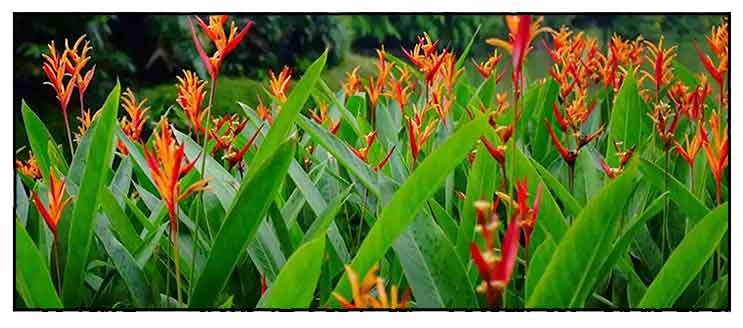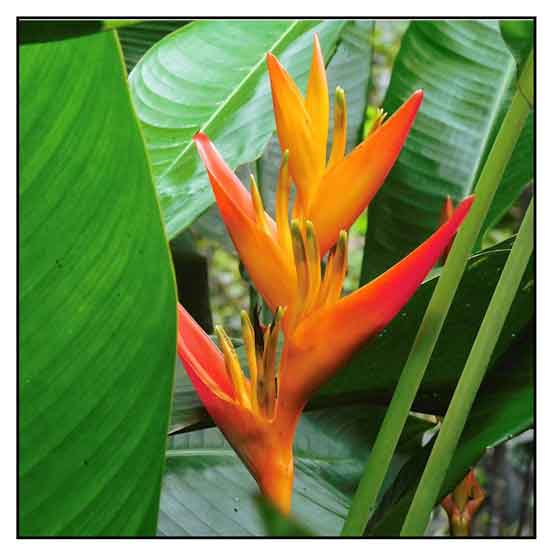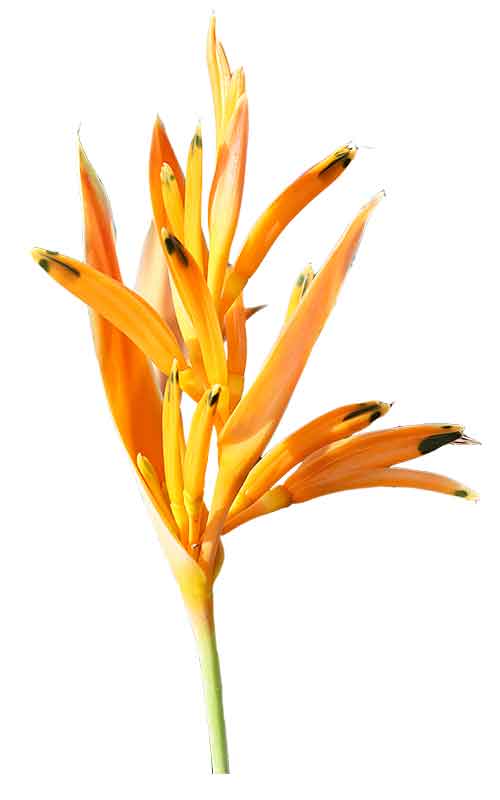 Gen info Gen info
- Heliconia is a genus of flowering plants in the monotypic family Heliconiaceae.
-
Etymology: The genus name Heliconia derives from "Heliconius" referring to Helicon, the mountain sacred to Apollo and to Moses in Greek mythology. Species name "psittacorum" is derived from Latin psittacus meaning "parrot" and referring to the flower shape resembling a parrot's beak.
 Botany Botany
• Heliconia psittacorum is an evergreen, perennial rhizomatous erect herbaceous species quickly forming 0,8-1,5 m tall dense tufts. The leaves, on an about 25 cm long petiole, are basal, alternate, simple, entire, elliptic-lanceolate to oblong-lanceolate with pointed apex and prominent central nervation in the lower page, 35-55 cm long and 4-12 cm broad, of bright intense green color above, paler below, and sheathing tubular foliar bases forming a pseudo-stem of about 2,5 cm of diameter. Inflorescence, on a 15-55 cm long peduncle, is an erect 6-12 cm long terminal spike with slightly waved rachis, usually orange, and 3-7 alternate, lanceolate, concave, waxy, bracts, slightly spaced, red to bright orange red, at times pink or lilac, the basal one 8-15 cm long, the others progressively decreasing. The bracts subtend 3-9 flowers, on a 1,6-1,8 cm long pedicel, tubular, usually orange with dark green spot towards the apex, 3-5 cm long. The flowers, with bilateral symmetry, are hermaphroditic, with 3 sepals, two of which merged and one free, and three petals fused together, little spaced between them, 5 fertile stamina and one staminode opposite to the free sepal; the flowers are pollinated by the hummingbirds. The fruits are sub-globose drupes initially yellow to orange, then glossy dark blue when ripe, of about 0,8 cm of diameter, containing 1-3 seeds. (8)
 Distribution Distribution
- Naturalized.
-
Native to Bolivia, Brazil North, Brazil Northeast, Brazil Southeast, Brazil West-Central, Colombia, French Guiana, Guyana, Panamá, Paraguay, Suriname, Trinidad-Tobago, Venezuela. (1)
- Naturalized in Thailand and other South East Asian countries.
- Ornamental cultivation.
- In the American Tropics, hummingbirds are the exclusive pollinators.
Constituents
- Phytochemical evaluation of extracts of H. psittacorum and H. rostrata yielded primary metabolites such as glucids and proteins, and secondary metabolites as phenolic compounds, terpenoids, and coumarins. (see study below) (5)
- Phytochemical screening of leaves yielded tannins, flavonoids, steroids, carbohydrates, fixed oil and fats, with absence of alkaloid, saponin, glycosides, and proteins.
Properties
- Studies have suggested antivenom, antibacterial, phytoremediative, cytotoxic, antioxidant, anti-angiogenic properties.
Uses
Folkloric
- No reported medicinal use in the Philippines.
- In Bogota, Columbia, used for muskuloskeletal complaints: arthritis, muscular paralysis, and rheumatism. (5)
- In South American, used for treatment of ulcers in the scalp."
- in Brazil, leaves used as topical emollient for external ulcers and skin scald wounds and burns. (7)
Others
- Handmade paper: Study done to evaluate producing handmade paper using H. psittacorum stalks. (see study below) (11)
Studies
• Copper Nanoparticles / Antibacterial / Leaf: Study reports on a green, single-step process using leaves of H. psittacorum as reducing and stabilizing agent that yielded stable, biogenic copper nanoparticles with prominent antibacterial potential for all tested bacterial strains. (3)
• Phytoremediation / Chromium / Heavy Metals: Study evaluated the effectiveness of Heliconia psittacorum as a potential phytoremediator of chromium (VI) in hydroponic crops. Results showed H. psittacorum was able to adopt to hydroponic crops with the presence of chromium (VI), absorbing heavy metals in their roots and accumulating them in greater proportion in the aerial parts. It is exclusive of chromium VI considering it suitable for phytoremediation. (4)
• Anti-Venom Effects: Some Heliconiaceae species have demonstrated efficacy in neutralizing partially or totally the lethal, indirect hemolytic, hemorrhagic, proteolytic, clotting and edema-forming activities of Bothrops asper venom. This study evaluated two species of heliconias: Heliconia psittacorum and H. rostrata against indirect hemolytic, proteolytic, and clotting activities induced by Bothrops asper (mapana equis). The extracts retarded the venom clotting effect. In the electrophoretic profile bands indicated degradation by the extracts. Phytochemical analysis yielded constituents reported in other vegetal species as responsible for the anti-ophidian activity. (see constituents above) (5)
• Antioxidant / Anti-Proliferative / Cytotoxic / Leaves: Study evaluated the cytotoxicity, anti-proliferative, and antioxidant effects of methanol extract and chloroform and aqueous fractions of leaves of Heliconia psittacorum and Ficus coronata using standard models. Concentration dependent anti-proliferative activity by growth inhibition of guinea corn seeds. Chloroform fractions were more cytotoxic against tadpoles than the aqueous fractions. Ferric reducing power assay at 40-100 µg/ml showed concentration-dependent antioxidant activity, which was higher for H. psittacorum, and was comparable to ascorbic acid. Results suggest potential for the treatment of oxidative stress-induced diseases. (9)
• Textile Wastewater Treatment: Preliminary observation indicated that Heliconia psittacorum in the HFCW (Horizontal Flow Constructed Wetland) system showed proficiency in textile wastewater treatment. H. psittacorum grew well in the system, suggesting the plant has high tolerance to complex and toxic textile wastewater. Long-term observation was needed for H. psittacorum in the HFCW system to reach steady state and to examine its potential to remediate textile wastewater. (10)
• Handmade Paper from Stalks: Study evaluated the possibility of producing handmade papers using Heliconia psittacorum. Papers were light brown, rough in texture, with a dry hay-like aroma, and the scribbled words legibly read. T3 (500 g pulp + 100 g starch dissolved and cooked in 750 cc of water) got the highest score of 0.474 mm thickness, 0.89 k Pa. m2/g in terms of burst, and 51.23 mN.m2/g terms of tear. (11)
• Anti-Angiogenic Activity / Quercetin / Leaves: Study evaluated the isolated quercetin from methanolic leaf extract of H. psittacorum. The extract showed good inhibition of E. coli and exhibited acceptable antioxidant activity. On Chorioallantoic membrane assay (CAM), the leaf extract showed strong anti-angiogenic activity at 100-150 µg/ml. (see constituents above) (12)
• Phytoremediation of Heavy Metals Contaminated Soil and Water / Hg, As. Cd: Study evaluated the use of H. psittacorum in remediating soils polluted with mercury (Hg), arsenic (As), cadmium (Cd), and lead (Pb). There was high bio-absorption rate of As, Hg, and Cd, whether as individual contaminant or all four together in the water. Results suggest the macrophyte can remediate As, Hg, and Cd in soil and water and has potential as cost-effective green technology in remediating heavy metal contaminated soil/water. (13)
Availability
- Wild-crafted.
- Plants in the cybermarket.
|

![]()






